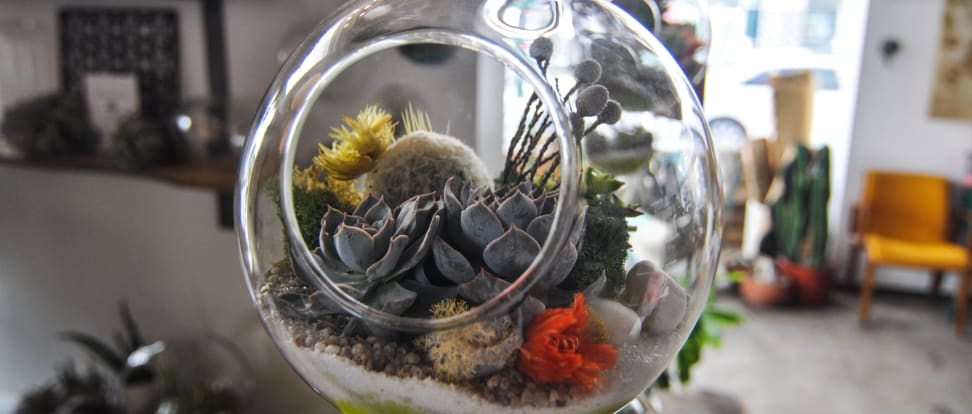 Credit:
Credit:
Recommendations are independently chosen by Reviewed's editors. Purchases made through the links below may earn us and our publishing partners a commission.
Potted palms are a cliché. Fern bars died in the 1980s. But that doesn’t mean a little greenery isn’t welcome in your house. So allow us to introduce a new concept: succulent terrariums.
Succulents are wonderfully easy to grow. Outdoors, they thrive in dry, warm climates and need little irrigation, making them a terrific drought-tolerant option for gardens. Few species will survive frost, but you don’t have to live in the desert to grow these plants year-round—just shelter them indoors.
Succulents do well when planted in traditional pots and containers, and with the right care they’re surprisingly hardy. They can serve as a striking accent for an entryway, or as a handsome centerpiece for the dinner table.
{{photo_gallery "succulent-terrarium-gallery"}}
Terrariums are a great way to showcase the unusual beauty of these extraterrestrial beings. Traditionally used as a living environment for reptiles or amphibians, glass terrariums also work well for plants that require a minimum of water and the maximum possible light. Some of the design concepts we’ve spotted lately use these planting environment to smashing visual effect.
Creating your own terrarium for succulents is surprisingly easy, and the finished product makes a great personalized gift. Yet in total, the individual ingredients typically cost under $50. Of course, the recipient has to take responsibility for the care and feeding, but that's easy too.
Build It Yourself
Gift and homewares store Pigment sells all the ingredients to build your own terrarium. Here are the supplies you’ll need to create your beautiful new centerpiece:
- A glass orb
- Soil (see below) and sand
- Succulent plants
- Accent features (small rocks or moss)
- Gloves (if including cactus)
- A small paintbrush
- Oversized tweezers
- A syringe for watering
Choosing the Right Plants
There is a wide range of succulents that will work in a small terrarium—we love the malevolent, Ursula-like tentacles of the zebra plant. Bulbous lithops mimic flat-topped rocks—hence their nickname, "living stones."
Try to select several species that will provide contrasting colors, shapes, and textures, or mix in some cacti to spice up your arrangement. (Botanically, cacti are also succulents.)
Air plants are often used in terrariums but, unlike succulents, they don’t need soil and have different watering requirements (occasional misting). They won’t necessarily play well in the terrarium with succulents.
Assembling the Terrarium
Pigment's own Chelsea Smith walked us through the steps you need to follow to create your own orb terrarium.
First, you fill the base of the orb with a medium-thin layer of sand. The plants won’t grow in the sand—it merely serves as a decorative feature that helps the plants stand out more than they might against dark brown dirt.
Using a paintbrush, push the sand away from the center, creating a small crater. (By the way, a jar lid makes a great DIY stand for your orb while you’re doing the groundwork.)
Spoon a layer of soil into the crater you've made. Because the orb has no drainage and most succulents need very little water, you’ll want to use cactus soil mix or a similar blend that keeps roots from getting too wet. You might want to incorporate granulated pumice, which has air pockets that absorb excess water.
Break off excess soil from the roots of your succulents to loosen them. Nestle the roots of the plants into the soil crater. Since the orb's opening may be small, long-handled tweezers might help you position them.
“Make sure you’re planting them into the soil, not the sand,” says Smith. “They’ll need the soil to survive.”
In arranging the plants you’ll probably find one that dominates—probably the largest or most colorful. Arrange the other plants around this focal point. Fill in any gaps with additional soil and tamp lightly to secure the roots, evening the surface.
After the succulents are in place, add a thin layer of sand on top to conceal the soil. You can use white sand, but consider color-tinted sand, which creates an exotic, other-worldly visual element. To get at hard-to-reach corners, make a funnel from a sheet of paper. Use a small paintbrush to dust off any sand that might be deposited on the plants, and to smooth the surface.
“Accessories like small rocks or moss add a finishing touch,” says Smith. “They’re another texture that makes the terrarium more interesting.”
How to Care for It
Your finished product is ready for display. Hang it near a window that provides bright light, but avoid direct sunlight. East-, west-, or south-facing windows are best.
Be sure not to overwater. Use a syringe or eyedropper to water directly at the base of the plant, every 7-10 days during summer months and every two to three weeks in winter. Since there’s no drainage, overwatering will lead to root rot or excessive growth.
Don’t worry if leaves shrivel up or dry out, just as long as they’re not from the top of the plant, where the new growth appears. The lower leaves will naturally wilt and fall off as the plant grows. Use tweezers to pluck them out.

